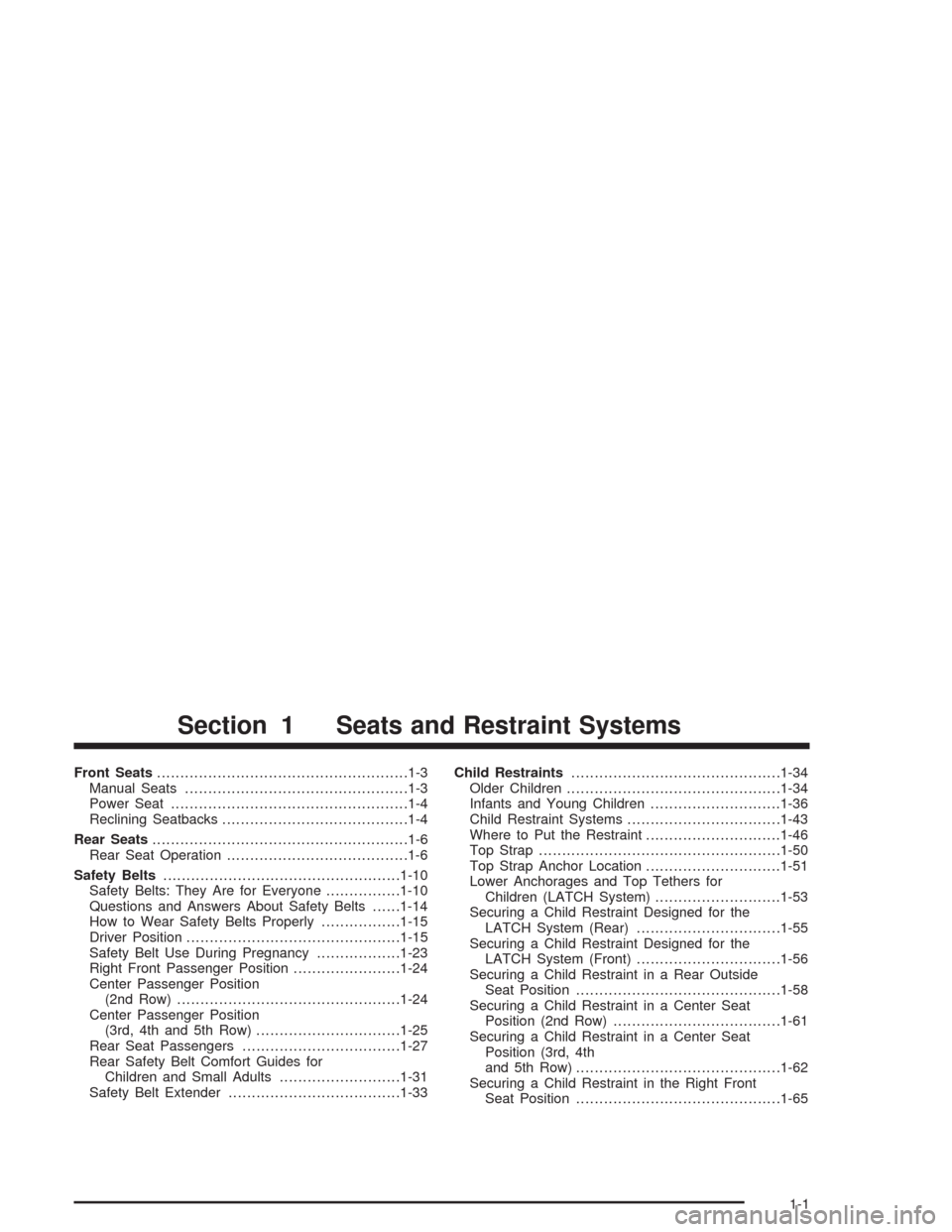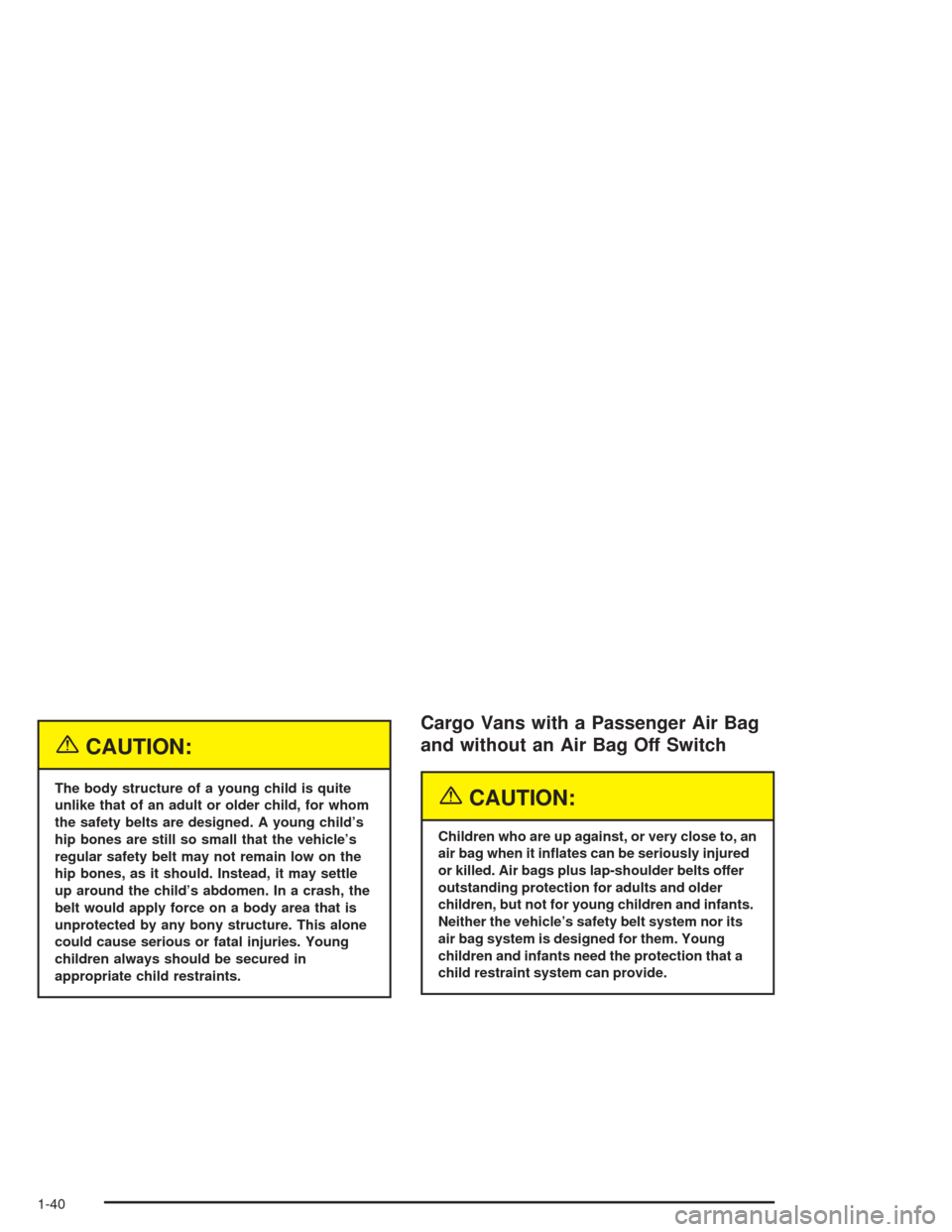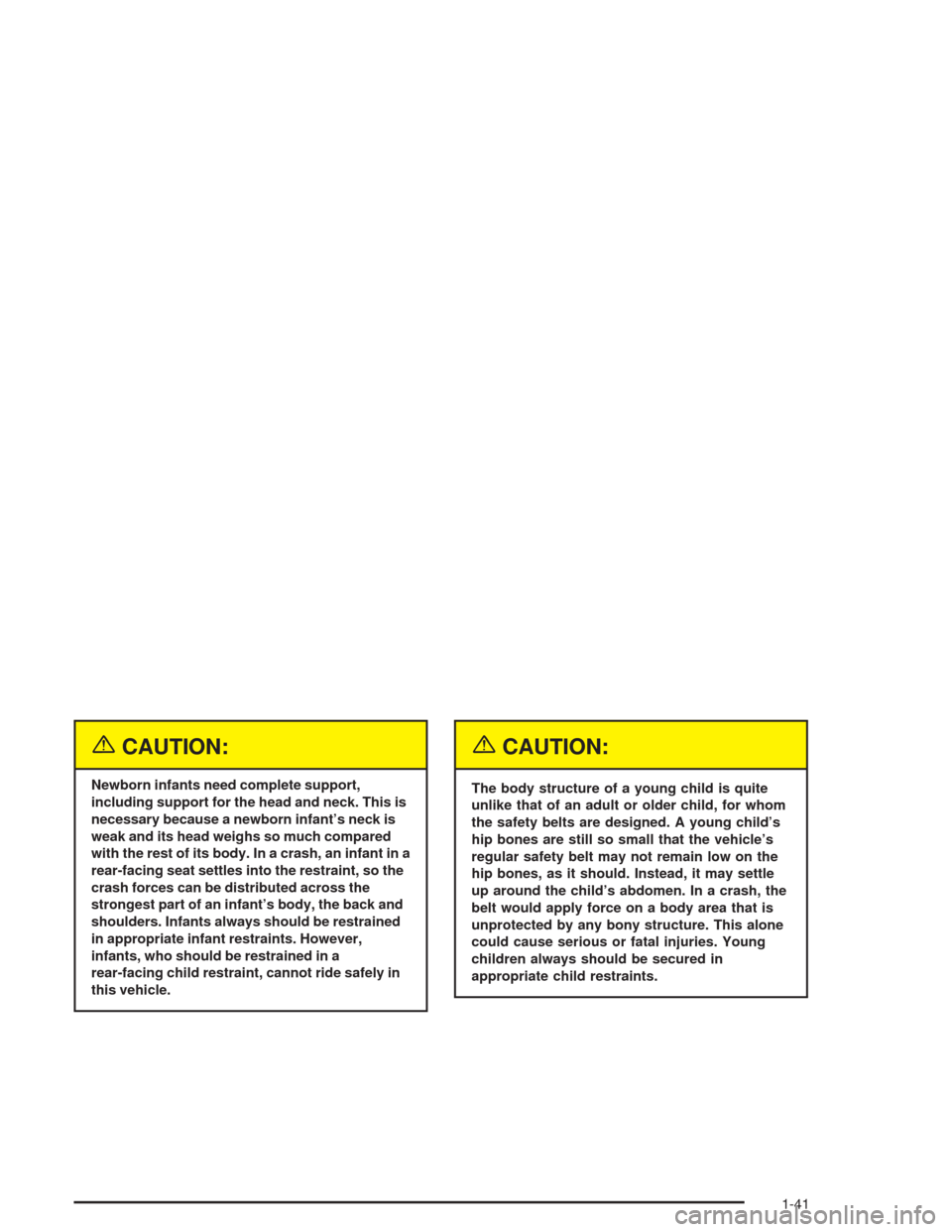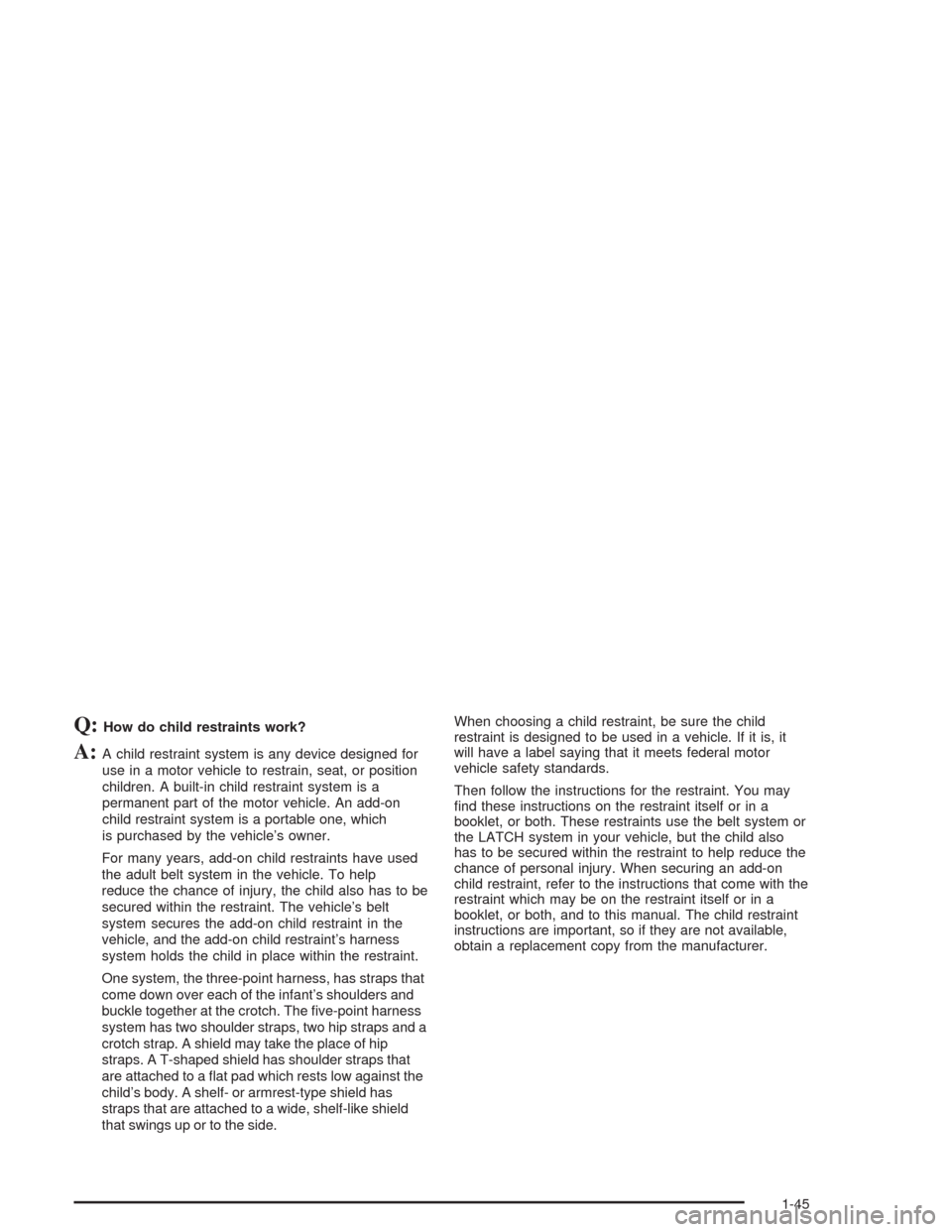Page 7 of 406

Front Seats......................................................1-3
Manual Seats................................................1-3
Power Seat...................................................1-4
Reclining Seatbacks........................................1-4
Rear Seats.......................................................1-6
Rear Seat Operation.......................................1-6
Safety Belts...................................................1-10
Safety Belts: They Are for Everyone................1-10
Questions and Answers About Safety Belts......1-14
How to Wear Safety Belts Properly.................1-15
Driver Position..............................................1-15
Safety Belt Use During Pregnancy..................1-23
Right Front Passenger Position.......................1-24
Center Passenger Position
(2nd Row)................................................1-24
Center Passenger Position
(3rd, 4th and 5th Row)...............................1-25
Rear Seat Passengers..................................1-27
Rear Safety Belt Comfort Guides for
Children and Small Adults..........................1-31
Safety Belt Extender.....................................1-33Child Restraints.............................................1-34
Older Children..............................................1-34
Infants and Young Children............................1-36
Child Restraint Systems.................................1-43
Where to Put the Restraint.............................1-46
Top Strap....................................................1-50
Top Strap Anchor Location.............................1-51
Lower Anchorages and Top Tethers for
Children (LATCH System)...........................1-53
Securing a Child Restraint Designed for the
LATCH System (Rear)...............................1-55
Securing a Child Restraint Designed for the
LATCH System (Front)...............................1-56
Securing a Child Restraint in a Rear Outside
Seat Position............................................1-58
Securing a Child Restraint in a Center Seat
Position (2nd Row)....................................1-61
Securing a Child Restraint in a Center Seat
Position (3rd, 4th
and 5th Row)............................................1-62
Securing a Child Restraint in the Right Front
Seat Position............................................1-65
Section 1 Seats and Restraint Systems
1-1
Page 22 of 406
3. Pick up the latch plate and pull the belt across you.
Don’t let it get twisted.
4. Push the latch plate into the buckle until it clicks.
Pull up on the latch plate to make sure it is secure.
If the belt isn’t long enough, seeSafety Belt
Extender on page 1-33.
Make sure the release button on the buckle is
positioned so you would be able to unbuckle the
safety belt quickly if you ever had to.5. To make the lap part tight, pull down on the buckle
end of the belt as you pull up on the shoulder belt.
1-16
Page 34 of 406
Lap-Shoulder Belt
Here’s how to wear a lap-shoulder belt properly.1. Pick up the latch plate and pull the belt across you.
Don’t let it get twisted.
2. Push the latch plate into the buckle until it clicks.
Pull up on the latch plate to make sure it is secure.
When the shoulder belt is pulled out all the way
you will engage the child restraint locking feature. If
this happens, just let the belt go back all the way
and start again.
If the belt is not long enough, seeSafety Belt
Extender on page 1-33.
Make sure the release button on the buckle is
positioned so you would be able to unbuckle the
safety belt quickly if you ever had to.
1-28
Page 43 of 406
Every time infants and young children ride in vehicles,
they should have the protection provided by the
appropriate restraint. Young children should not use the
vehicles safety belts without an additional restraint,
unless there is no other choice.
Cargo Vans with a Passenger Air Bag
and an Air Bag Off Switch, Passenger
Vans and Cab and Chassis Models
{CAUTION:
People should never hold a baby in their arms
while riding in a vehicle. A baby does not
weigh much -- until a crash. During a crash a
baby will become so heavy it is not possible to
hold it. For example, in a crash at only 25 mph
(40 km/h), a 12-lb. (5.5 kg) baby will suddenly
become a 240-lb. (110 kg) force on a person’s
arms. A baby should be secured in an
appropriate restraint.
1-37
Page 45 of 406
For most basic types of child restraints, there are
many different models available. When purchasing a
child restraint, be sure it is designed to be used
in a motor vehicle. If it is, the restraint will have a
label saying that it meets federal motor vehicle
safety standards.
The restraint manufacturer’s instructions that come
with the restraint state the weight and height
limitations for a particular child restraint. In addition,
there are many kinds of restraints available for
children with special needs.
{CAUTION:
Newborn infants need complete support,
including support for the head and neck. This
is necessary because a newborn infant’s neck
is weak and its head weighs so much
compared with the rest of its body. In a crash,
an infant in a rear-facing seat settles into the
restraint, so the crash forces can be
distributed across the strongest part of an
infant’s body, the back and shoulders. Infants
always should be secured in appropriate infant
restraints.
1-39
Page 46 of 406

{CAUTION:
The body structure of a young child is quite
unlike that of an adult or older child, for whom
the safety belts are designed. A young child’s
hip bones are still so small that the vehicle’s
regular safety belt may not remain low on the
hip bones, as it should. Instead, it may settle
up around the child’s abdomen. In a crash, the
belt would apply force on a body area that is
unprotected by any bony structure. This alone
could cause serious or fatal injuries. Young
children always should be secured in
appropriate child restraints.
Cargo Vans with a Passenger Air Bag
and without an Air Bag Off Switch
{CAUTION:
Children who are up against, or very close to, an
air bag when it in�ates can be seriously injured
or killed. Air bags plus lap-shoulder belts offer
outstanding protection for adults and older
children, but not for young children and infants.
Neither the vehicle’s safety belt system nor its
air bag system is designed for them. Young
children and infants need the protection that a
child restraint system can provide.
1-40
Page 47 of 406

{CAUTION:
Newborn infants need complete support,
including support for the head and neck. This is
necessary because a newborn infant’s neck is
weak and its head weighs so much compared
with the rest of its body. In a crash, an infant in a
rear-facing seat settles into the restraint, so the
crash forces can be distributed across the
strongest part of an infant’s body, the back and
shoulders. Infants always should be restrained
in appropriate infant restraints. However,
infants, who should be restrained in a
rear-facing child restraint, cannot ride safely in
this vehicle.
{CAUTION:
The body structure of a young child is quite
unlike that of an adult or older child, for whom
the safety belts are designed. A young child’s
hip bones are still so small that the vehicle’s
regular safety belt may not remain low on the
hip bones, as it should. Instead, it may settle
up around the child’s abdomen. In a crash, the
belt would apply force on a body area that is
unprotected by any bony structure. This alone
could cause serious or fatal injuries. Young
children always should be secured in
appropriate child restraints.
1-41
Page 51 of 406

Q:How do child restraints work?
A:A child restraint system is any device designed for
use in a motor vehicle to restrain, seat, or position
children. A built-in child restraint system is a
permanent part of the motor vehicle. An add-on
child restraint system is a portable one, which
is purchased by the vehicle’s owner.
For many years, add-on child restraints have used
the adult belt system in the vehicle. To help
reduce the chance of injury, the child also has to be
secured within the restraint. The vehicle’s belt
system secures the add-on child restraint in the
vehicle, and the add-on child restraint’s harness
system holds the child in place within the restraint.
One system, the three-point harness, has straps that
come down over each of the infant’s shoulders and
buckle together at the crotch. The �ve-point harness
system has two shoulder straps, two hip straps and a
crotch strap. A shield may take the place of hip
straps. A T-shaped shield has shoulder straps that
are attached to a �at pad which rests low against the
child’s body. A shelf- or armrest-type shield has
straps that are attached to a wide, shelf-like shield
that swings up or to the side.When choosing a child restraint, be sure the child
restraint is designed to be used in a vehicle. If it is, it
will have a label saying that it meets federal motor
vehicle safety standards.
Then follow the instructions for the restraint. You may
�nd these instructions on the restraint itself or in a
booklet, or both. These restraints use the belt system or
the LATCH system in your vehicle, but the child also
has to be secured within the restraint to help reduce the
chance of personal injury. When securing an add-on
child restraint, refer to the instructions that come with the
restraint which may be on the restraint itself or in a
booklet, or both, and to this manual. The child restraint
instructions are important, so if they are not available,
obtain a replacement copy from the manufacturer.
1-45